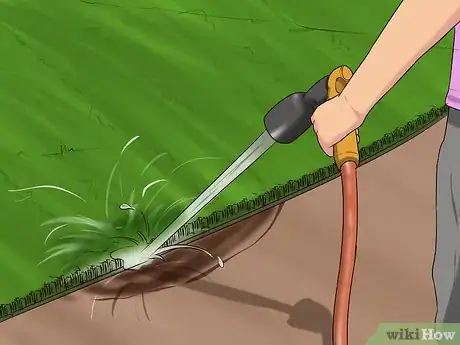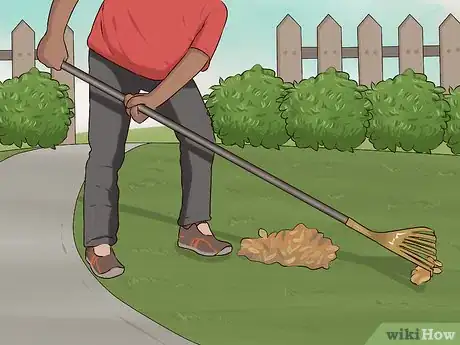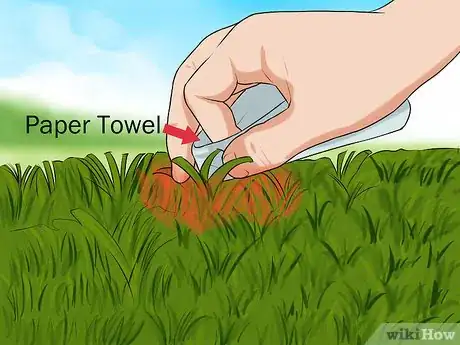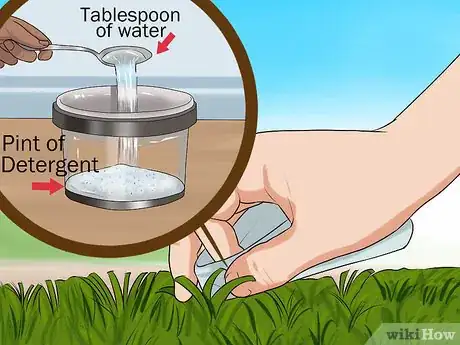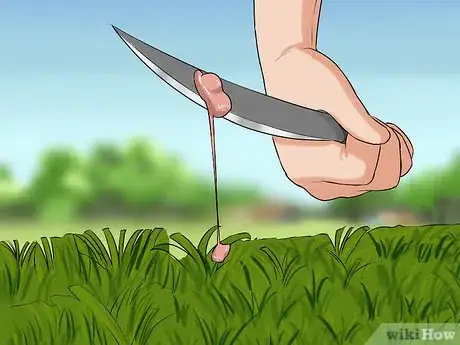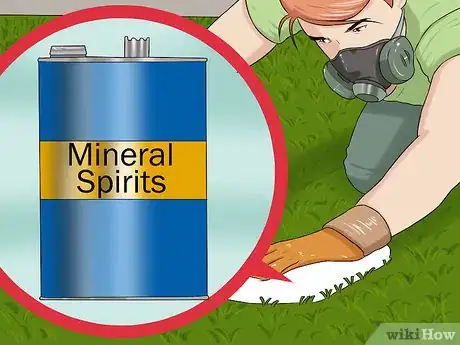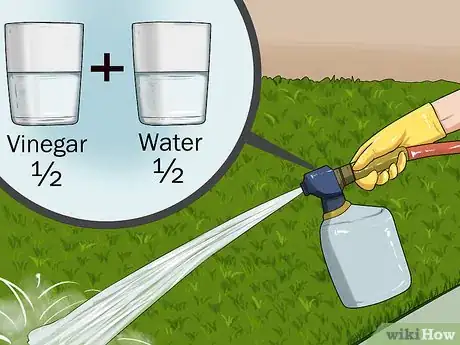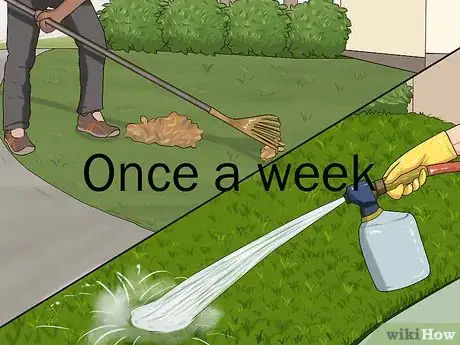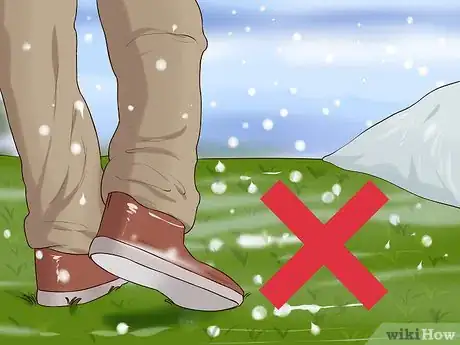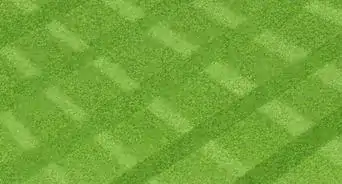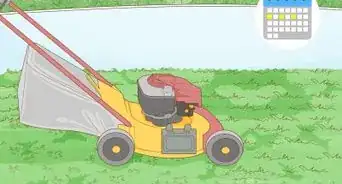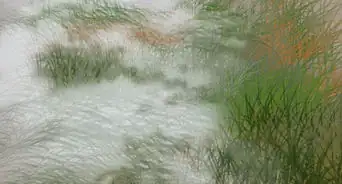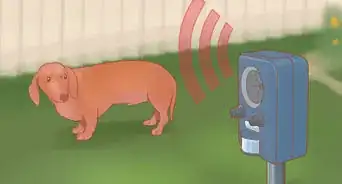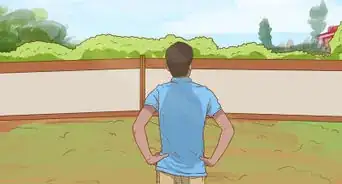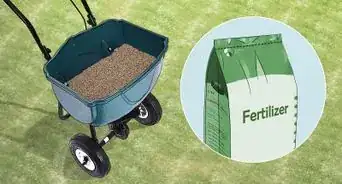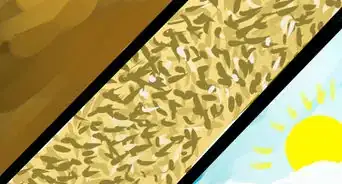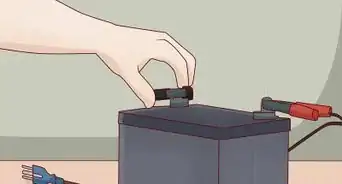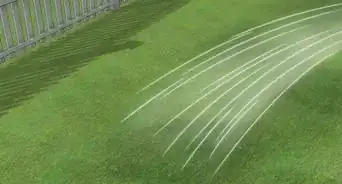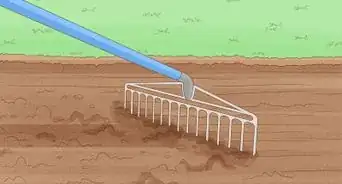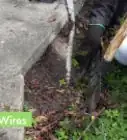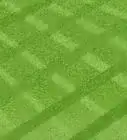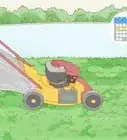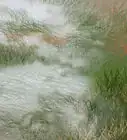This article was co-authored by Grant Wallace. Grant Wallace is a Landscaper and Owner of Grantlanta Lawn in Atlanta, Georgia. With over seven years of experience, he specializes in lawn maintenance and landscape installation. In 2012, he earned his BA from the University of West Georgia. Grant has been profiled in Shoutout Atlanta, Canvas Rebel, and Voyage ATL.
There are 7 references cited in this article, which can be found at the bottom of the page.
This article has been viewed 141,303 times.
Artificial grass has many advantages over mother nature’s alternative. For one, it doesn’t need any fertilizer, or any other specific care to maintain its lush look. It stays healthy throughout the seasons, and doesn’t need mowing come summer. Artificial grass is also incredibly easy to clean. Simple upkeep should be done regularly, and cleaning up specific spills is easy as well.
Steps
Cleaning Grass Regularly
-
1Use a leaf blower to get rid of debris. Whether it be fallen leaves in autumn, fallen branches after a storm or some other accumulation of debris, a leaf blower can help you swiftly clear your turf. Designate one corner of your yard and blow all debris towards it. Once all debris is grouped, you can collect it for removal. You should only have to pass over the turf once to completely clear it of larger debris.[1]
-
2Rinse the turf with a garden hose. While a leaf blower is effective for larger debris, it might not clear the grass of dust or spills. Using a garden hose, rinse the entirety of the turf. Make sure to do so lightly; too much water pressure could damage the grass. Start from one end of your yard, moving across and sweeping the hose in a circular motion as you do.[2]Advertisement
-
3Brush the grass using a broom or rake.[3] Brushing the grass frequently will keep the grass blades pointed upwards, affording your lawn a more natural look. You can use a brush, as long as it has soft bristles. However, you’ll be better served using a broom or a rake; the added reach will make covering the whole yard easier and quicker. Start in one corner of your yard, and move horizontally as you brush. Once you’ve reached the opposite end, take a few steps back, and move across again.[4]
- You should always brush in the same direction, against the grass’ natural grain.
Removing Spills and Stains
-
1
-
2Clean any stains with a solution of water and granular detergent. Mix a teaspoon of water with a pint of detergent in a container you can easily carry around. A bucket is your best bet for this. You can use a sponge or a soft cloth to rub the solution into the stain until it’s dislodged.
- Once the stain is dislodged, you can rinse away the detergent with a garden hose.
- This mild solution won’t damage your grass, and can clean up a variety of substances, such as coffee, alcohol or ice cream.[7]
-
3Scrape pasty or sticky residues off with a knife. Whether you’re dealing with gum, lipstick, crayon residue or paint, gently scrape it off the grass. Be careful not to accidentally cut the grass as you scrape. Follow the grass upwards with the knife rather than scrapping across.[8]
-
4Use mineral spirits to remove signs of solid debris. Soak a soft cloth in mineral spirits, then wipe the soiled blades of grass. Take care when cleaning with mineral spirits; you want to make sure the mineral spirits doesn’t go past the grass and beneath the turf as this could cause serious damage.[9]
- Wear gloves when using mineral spirits, as it can irritate bare skin.
- Wear a respirator when working with mineral spirits, as the fumes can be toxic.[10]
Maintaining Artificial Grass
-
1Use a half vinegar, half water solution to kill bacteria. Artificial grass is a lot less likely to collect bacterial spores than natural grass; however it’s still possible, especially if you have pets. If you only need to spray a specific spot, just use a spray bottle. If you suspect the bacteria is more widespread, attach a hose-end sprayer to a garden hose and hose down the whole turf.[11]
- A hose-end sprayer looks like a plastic bottle with a spray bottle nozzle. It screws into a garden hose and is usually used to spray fertilizer.[12]
-
2Hose and brush the turf once a week. Use a garden hose to spray water on your grass. This will keep it looking fresh as well as ridding it of small spills and odors. After hosing, use a broom or a rake to brush the grass. This will keep the grass blades pointing upwards, helping your lawn look fresh.
-
3Avoid treading on artificial grass during winter. Snow and ice won’t damage the grass by themselves, but walking on the grass too much can cause snow to turn into a layer of ice. If this does happen, avoid the temptation to remove the ice, as this could damage the grass blades. Instead, you should wait until the snow and ice melt naturally.
- Avoid using salt to melt snow or ice. The residue can damage the grass’ carpet backing and prevent the lawn from draining properly.[13]
Community Q&A
-
QuestionHow can I get rid of the smell of pet urine?
 Michael KarrCommunity AnswerRemove as much of the urine as possible by blotting at it. Clean the area with baking soda and water. Whatever you do, do not use a steam cleaner; this will make the smell worse and drive the stain further into the fibers. Look into using an odor neutralizer as well.
Michael KarrCommunity AnswerRemove as much of the urine as possible by blotting at it. Clean the area with baking soda and water. Whatever you do, do not use a steam cleaner; this will make the smell worse and drive the stain further into the fibers. Look into using an odor neutralizer as well. -
QuestionWhat should I use to push out water that has pooled from rain on artificial grass?
 Community AnswerYou can use a shop vac to suck up the water that has pooled in the area. This also helps keep your turf from smelling bad.
Community AnswerYou can use a shop vac to suck up the water that has pooled in the area. This also helps keep your turf from smelling bad. -
QuestionWhat's the best way to clean artificial grass?
 Community AnswerIt depends what you need to clean. A good maintenance routine should include at least a yearly clean, which should include; blowing large debris off the grass using a power blower, power brooming to remove organic materials that have fallen in between the grass blades, rinsing with water from a garden hose, and lastly spraying with a powerful enzyme cleaner to kill bacteria, especially if you have pets.
Community AnswerIt depends what you need to clean. A good maintenance routine should include at least a yearly clean, which should include; blowing large debris off the grass using a power blower, power brooming to remove organic materials that have fallen in between the grass blades, rinsing with water from a garden hose, and lastly spraying with a powerful enzyme cleaner to kill bacteria, especially if you have pets.
Expert Interview
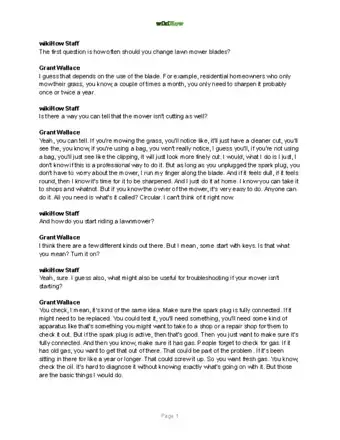
Thanks for reading our article! If you'd like to learn more about cleaning grass, check out our in-depth interview with Grant Wallace.
References
- ↑ http://www.artificialgrassliquidators.com/how-to-clean-artificial-grass/
- ↑ http://www.installitdirect.com/blog/artificial-grass-maintenance/
- ↑ https://easigrass.co.za/blog/keeping-your-artificial-grass-clean/
- ↑ http://www.installitdirect.com/blog/artificial-grass-maintenance/
- ↑ https://easigrass.co.za/blog/keeping-your-artificial-grass-clean/
- ↑ https://3eo9mbo54up347ktbpjsxo19-wpengine.netdna-ssl.com/wp-content/uploads/2011/06/care_and_maintenance_of_synlawn.pdf
- ↑ https://3eo9mbo54up347ktbpjsxo19-wpengine.netdna-ssl.com/wp-content/uploads/2011/06/care_and_maintenance_of_synlawn.pdf
- ↑ https://3eo9mbo54up347ktbpjsxo19-wpengine.netdna-ssl.com/wp-content/uploads/2011/06/care_and_maintenance_of_synlawn.pdf
- ↑ https://3eo9mbo54up347ktbpjsxo19-wpengine.netdna-ssl.com/wp-content/uploads/2011/06/care_and_maintenance_of_synlawn.pdf
About This Article
To clean artificial grass, hose it down once a week with a solution of equal parts vinegar and water, which will kill any bacteria collected in its blades. If your grass has any stains, like coffee, alcohol, or ice cream, mix together 1 pint of granular detergent and 1 teaspoon of water and use a cloth to rub the solution into the stain until it’s gone. Once it’s removed, you can rinse away the detergent with a garden hose. To give your artificial grass a more natural look, brush it regularly with a broom or rake, as this will keep the grass blades pointed upwards. For more help, including how to use mineral spirits to remove solid debris, read on.

